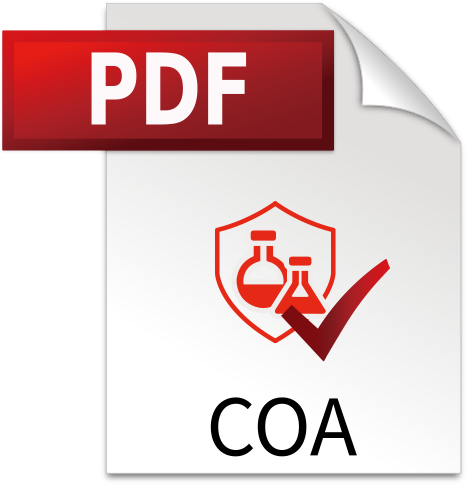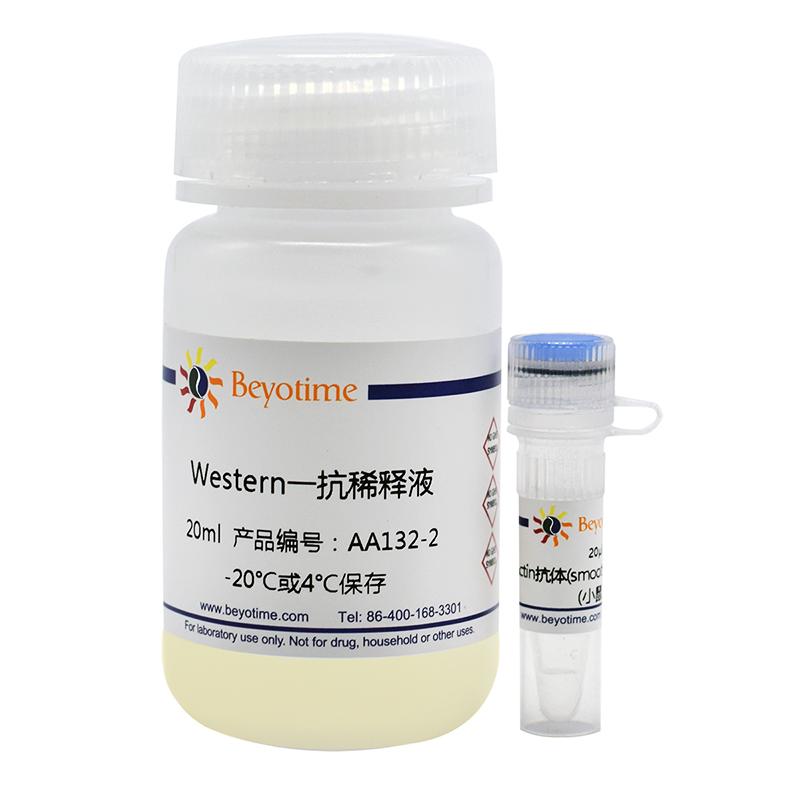| 来源 |
用途 |
可检测样品 |
抗体类型 |
α-actin分子量 |
| Mouse |
WB, IF, IHC, ELISA |
Mam, C, S, Fr |
IgG2a |
~42kD |
WB, Western blot; IF, Immunofluorescence; IHC, Immunohistochemistry.
Mam, mammalian, including human, mouse, rat, bovine, sheep, pig, rabbit, dog, guinea pig; C, chicken; S, snake; Fr, frog.
本Actin抗体特异性识别α-smooth muscle actin,为进口分装,用人工合成的α-smooth muscle actin N-terminal一段十肽作为抗原制备而成的抗α-smooth muscle actin小鼠单克隆抗体。克隆号为1A4。本Actin抗体(smooth muscle specific)在Western blot或免疫染色时仅识别α-smooth muscle actin。
Actin即肌动蛋白,是细胞的一种重要骨架蛋白。同时Actin在细胞分泌、吞噬、locomotion、cytoplasmic streaming和cytokinesis等过程中起重要作用。Actin在不同物种之间高度保守,以至于很难获得较好的针对actin的抗血清。Actin大致可分为六种,其中四种是不同肌肉组织特异性的,包括α-skeletal muscle actin,α-cardiac muscle actin,α-smooth muscle actin,和γ-smooth muscle actin;其余两种广泛分布于各种组织中,包括β-actin(β-non-muscle)和γ-non-muscle actin。不同的actin之间同源性大于90%,但在N-terminal同源性仅50-60%,因此N-terminal常被用作actin的抗原。
α-smooth muscle actin的免疫染色可以用于判断是否是smooth muscle。
配套提供了Western一抗稀释液,可以用于Western检测时的一抗稀释。
建议抗体使用时的稀释比例如下(实际使用时需根据抗原水平的高低作适当调整):
| WB |
IF |
IHC |
ELISA |
| 1:1000 |
1:400 |
1:400 |
1:1000-5000 |
本抗体如果用于常规的Western检测,至少可以检测20次。
包装清单:
| 产品编号 |
产品名称 |
包装 |
| AA132-1 |
Actin抗体(smooth muscle specific, 小鼠单抗) |
20μl |
| AA132-2 |
Western一抗稀释液 |
20ml |
| - |
说明书 |
1份 |
保存条件:
Actin抗体(smooth muscle specific)-20℃保存,Western一抗稀释液-20℃或4℃保存,一年有效。Western一抗稀释液优先推荐4℃保存,长期不使用可以考虑-20℃保存,但冻融可能会导致出现轻微的浑浊和少量不溶物。
注意事项:
在Western实验后,请注意回收稀释的抗体。回收的抗体在进行Western实验时至少可以重复使用10次。稀释后的抗体,包括已经使用过的稀释抗体,4℃保存。
回收后重复使用的抗体,使用方法同新鲜稀释的抗体。如果在重复使用过程中发现抗体出现轻微混浊现象,可以10000g离心1-3分钟,取上清用于后续检测。如果回收的抗体出现明显的絮状物或长霉长菌等情况,则可以考虑废弃该抗体。
本产品仅限于专业人员的科学研究用,不得用于临床诊断或治疗,不得用于食品或药品,不得存放于普通住宅内。
为了您的安全和健康,请穿实验服并戴一次性手套操作。
使用本产品的文献:
1. Wang X, Huang N, Yang M, Wei D, Tai H, Han X, Gong H, Zhou J, Qin J, Wei X, Chen H, Fang T, Xiao H.
FTO is required for myogenesis by positively regulating mTOR-PGC-1α pathway-mediatedmitochondria biogenesis.
Cell Death Dis. 2017 Mar 23;8(3):e2702. (IF 6.304)
2. Wang WY, Zhang J, Wu WY, Li J, Ma YL, Chen WH, Yan H, Wang K, Xu WW, Shen JH, Wang YP.
Inhibition of lipoprotein-associated phospholipase A2 ameliorates inflammation and decreasesatherosclerotic plaque formation in ApoE-deficient mice.
PLoS One. 2011;6(8):e23425. (IF 2.74)
3. Wu X, Liu BJ, Ji S, Wu JF, Xu CQ, Du YJ, You XF, Li B, Le JJ, Xu HL, Duan XH, Dong JC.
Social defeat stress promotes tumor growth and angiogenesis by upregulating vascular endothelial growth factor/extracellular signal-regulated kinase/matrix metalloproteinase signaling in a mouse model of lung carcinoma.
Mol Med Rep. 2015 Jul;12(1):1405-12. (IF 2.1)
4. Li Y, Pu G, Chen C, Yang L.
Inhibition of FHL1 inhibits cigarette smoke extract-induced proliferation in pulmonary arterial smooth muscle cells.
Mol Med Rep. 2015 Sep;12(3):3801-8. (IF 2.1)
5. Guang Jun Chen, Yi Heng Chen, Xia Qing Yang, Zhi Jie Li.
Nano-microcapsule basic fibroblast growth factor combined with hypoxia-inducible factor-1 improves random skin flap survival in rats..
Molecular medicine. 2016 Feb;13(2):1661-6. (IF 2.991)
6. Fang Zhou, Aiguo Dai, Yongliang Jiang, Xiaowu Tan, Xiufeng Zhang.
SENP 1 enhances hypoxia induced proliferation of rat pulmonary artery smooth muscle cells by regulating hypoxia inducible factor 1α.
Molecular medicine. 2016 Mar;13(4):3482-90. (IF 2.991)
7. Sun Q, Wu Y, Zhao F, Wang J.
Maresin 1 inhibits transforming growth factor-β1-induced proliferation, migration and differentiation in human lung fibroblasts.
Mol Med Rep. 2017 Aug;16(2):1523-1529. (IF 2.1)
8. Jiang Y, Zhou Y, Peng G, Liu N, Tian H, Pan D, Liu L, Yang X, Li C, Li W, Chen L, Ran P, Dai A
Topotecan prevents hypoxia-induced pulmonary arterial hypertension and inhibits hypoxia-inducible factor-1α and TRPC channels.
INT J BIOCHEM CELL B. 2018 Nov;104:161-170. (IF 3.673)
9. Zhang L, Li B, Zhang B, Zhang H, Suo J
miR-361 enhances sensitivity to 5-fluorouracil by targeting the FOXM1-ABCC5/10 signaling pathway in colorectal cancer.
Oncol Lett. 2019 Oct;18(4):4064-4073. (IF 2.311)
10. Min Ma, Xia-Hui Lin, Hua-Hua Liu, Rui Zhang, Rong-Xin Chen
Suppression of DRP1‑mediated mitophagy increases the apoptosis of hepatocellular carcinoma cells in the setting of chemotherapy
Oncol Rep. 2020 Mar;43(3):1010-1018.;doi: 10.3892/or.2020.7476. (IF 3.417)
11. Yunhe Lu, Liangdong Li, Lei Chen, Yang Gao, Xin Chen, Yiqun Cao
TRIB3 confers glioma cell stemness via interacting with β-catenin
Environ Toxicol. 2020 Jun;35(6):697-706.;doi: 10.1002/tox.22905. (IF 3.118)
12. Xinnong Liu, Chengjia Qu, Yongbao Zhang, Jie Fang, Lequn Teng, Rujiao Zhang, Xiangyu Zhang, Chenyang Shen
Chemokine-like factor 1 (CKLF1) aggravates neointimal hyperplasia through activating the NF-κB /VCAM-1 pathway
FEBS Open Bio. 2020 Sep;10(9):1880-1890.;doi: 10.1002/2211-5463.12942. (IF 2.231)
13. Chaowei Hu, Jing Li, Yunhui Du, Juan Li, Yunyun Yang, Yifan Jia, Lu Peng, Yanwen Qin, Yongxiang Wei
Impact of chronic intermittent hypoxia on the long non-coding RNA and mRNA expression profiles in myocardial infarction
J Cell Mol Med. 2021 Jan;25(1):421-433.;doi: 10.1111/jcmm.16097. (IF 4.486)
14. Lingang Xu, Nan Sun, Guangshuai Li, Linbo Liu
LncRNA H19 promotes keloid formation through targeting the miR-769-5p/EIF3A pathway
Mol Cell Biochem. 2021 Mar;476(3):1477-1487.;doi: 10.1007/s11010-020-04024-x. (IF 2.795)
15. Feng-Ying Gao, Ji-Cai Pang, Miao Wang, Mai-Xin Lu, Zhi-Gang Liu, Jian-Meng Cao, Xiao-Li Ke, Meng-Meng Yi
Structurally diverse genes encode TLR13 in Nile tilapia: The two receptors can recognize Streptococcus 23S RNA and conduct signal transduction through MyD88
Mol Immunol. 2021 Apr;132:60-78.;doi: 10.1016/j.molimm.2021.01.020. (IF 3.641)
 一键复制产品信息
一键复制产品信息  一键复制产品信息
一键复制产品信息 


